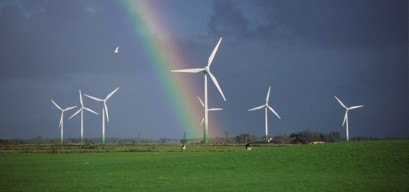
On Tuesday, the European Commission published a vital Communication on the road to a low carbon economy in 2050, stating categorically that the effort must start with an immediate increase in the EU's emissions reduction target. The European Wind Energy Association (EWEA) quickly responded, saying “moving now to 30% domestic emissions reductions by 2020 (instead of today's 20% target), together with targets for 2030 is necessary to achieve the long-term goals set out in the 2050 roadmap”.
The association clearly sees wind power as one of the key pieces in the puzzle regarding cutting European atmospheric emissions, and a recent study based upon the capacity of wind power at the end of 2010 and the regional distribution of wind turbines in Germany shows its ideals are well founded.
The IWR a renewable energy institute from Münster (Germany) has just determined the average level of energy production to be expected over the long term.
On the basis of wind data provided by the German Weather Office, wind revenue data from the German Association of Energy and Water Industries (BDEW) as well as the transition system operators and the wind power capacity in Germany, the yearly levels of wind performance were retrospectively simulated between 1971 to 2010.
In respect to the period of observation over the last 40 years, the wind power stations in Germany, having a total capacity of currently 27,299 megawatts (as of the end of 2010), would have produced 43.5 billion kilowatt hours. In extreme cases, the margin of yearly fluctuation spans from 36 billion kWh (year: 1996) on the low end up to 50 billion kWh in the upper range.
Within the period of investigation, years indicating a low level of wind during the simulation included 1971-2010, especially 1976, 1996, and this past 2010. Years yielding above-average levels wind thereby producing very high levels of energy were 1983, 1990, 1998 and 2007.
Winds of change
These findings may well spur the debate about the wind industry’s role in curbing emissions at EWEA’s annual conference in Brussels (EWEA 2011), Europe's largest Wind Energy Event (14 -17 March).
At the 4 day event 200 top speakers, CEOs and EU policy-makers including European Climate Action Commissioner Connie Hedegaard will debate EU energy policy beyond 2020 amongst a wide range of policy, technological, financial and other topics with several thousand participants. Key industry actors and bankers from financial and insurance institutes will debate investment strategies given the EU's commitment to reducing greenhouse gas emissions by 80-95% by 2050.
Hermann van Rompuy and Jerzy Buzek, the Presidents of the European Council and the European Parliament will address urgently needed political decisions (video messages). Present will be Lykke Friis, Minister for Climate and Energy from Denmark. For the Hungarian EU Presidency, Peter Olajos, State Secretary for Green Economy and Climate Change will lead the debate, as Italy's Secretary of State for Economic Development, Stefano Saglia. Arthouros Zervos, President, the European Wind Energy Association (EWEA), will explain how Europe needs to act to avoid being negatively affected by an EU energy policy vacuum.
420 energy technology companies from the small, such as Vortex, to the massive like Vestas, will attend EWEA 2011 to present the latest in new wind power technology. The event will take place at Brussels Expo.
For Additional information:

